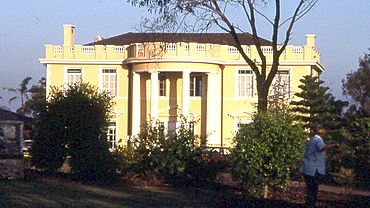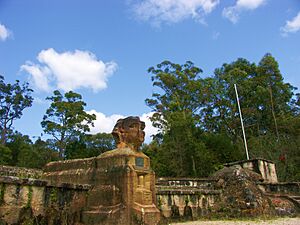North Turramurra facts for kids
Quick facts for kids North TurramurraSydney, New South Wales |
|||||||||||||||
|---|---|---|---|---|---|---|---|---|---|---|---|---|---|---|---|

Home in Bobbin Head Road
|
|||||||||||||||
| Population | 4,194 (2021 census) | ||||||||||||||
| • Density | 357.24/km2 (925.2/sq mi) | ||||||||||||||
| Established | 1850s | ||||||||||||||
| Postcode(s) | 2074 | ||||||||||||||
| Elevation | 163 m (535 ft) | ||||||||||||||
| Area | 11.74 km2 (4.5 sq mi) | ||||||||||||||
| Location | 22 km (14 mi) NW of Sydney | ||||||||||||||
| LGA(s) | Ku-ring-gai Council | ||||||||||||||
| State electorate(s) | Davidson | ||||||||||||||
| Federal Division(s) | Bradfield | ||||||||||||||
|
|||||||||||||||
North Turramurra is a suburb in Sydney, New South Wales, Australia. It's part of Sydney's Upper North Shore area. North Turramurra is about 20 kilometres (12 miles) north-west of the main city centre of Sydney. It is managed by the Ku-ring-gai Council, which is its local government area. Remember, North Turramurra is its own suburb, separate from Turramurra and South Turramurra.
Contents
The Story of North Turramurra
The name Turramurra comes from an Aboriginal word. It might mean big hill, high place, or small watercourse. Early settlers called this area Eastern Road. But when the railway station was built in 1890, the name Turramurra was chosen. Eastern Road used to be full of fruit orchards.
Early Settlers and Orchards
Samuel King was born in Ireland in 1828. He came to Sydney in 1853 with his wife, Ann. They started many orchards along Bobbin Head Road and in North Turramurra. Samuel King was also a big supporter of his church and community.
Saving the Bushland
A man named Eccleston du Faur helped make the name Turramurra official. He was born in England in 1832. In Sydney, he was known for supporting arts and sciences. He became a Fellow of the Royal Geographical Society in 1875. He was also one of the first people to work on protecting the bushland.
Most importantly, Du Faur helped get the land for the Ku-ring-gai Chase National Park from the government. This park was officially created in 1894. Du Faur even paid for and built a road through the bush to Bobbin Head. In 1895, he built a house on 25 acres (10 hectares) near the park gates. After he passed away in 1915, part of his land became Lady Davidson Home. This was a hospital for people recovering from illness or injury.
North Turramurra became its own separate suburb on August 5, 1994.
Cool Places to See
North Turramurra has a special war memorial called the Sphinx. It's a 1.5-metre (5-foot) tall copy of the famous Great Sphinx of Egypt. A soldier named William Shirley carved it out of sandstone in the 1920s. He made it to remember his friends who died in the war.
The suburb is also a great place for bushwalking. Many walking trails start here. You can easily get to Bobbin Head, the upper parts of Cowan Creek, and St Ives Chase.
Nature and Wildlife
North Turramurra is located on a narrow strip of land between two creeks. These creeks are Lovers Jump Creek and Cowan Creek. They both flow into the sea through the Ku-ring-gai Chase National Park. This park is on the northern edge of Sydney. North Turramurra is also the northern border of the Ku-ring-gai Council area.
The valleys around North Turramurra are covered in thick forests. This means there can be a risk of bushfires in summer. But it also means that people living here often see amazing native wildlife. It's common to spot wallabies hopping around in people's backyards!
Who Lives Here?
In 2021, North Turramurra had a population of 4,194 people.
- The average age here is 56 years old. This is older than the national average of 38 years. This is because there are many homes for older people in the area.
- About 14.1% of the people are under 15 years old.
- About 41.0% of the people are 65 years or older.
- Most people (64.7%) were born in Australia. Other common birthplaces include England (8.2%), China (3.6%), and South Africa (3.4%).
North Turramurra has a very friendly community. There's a strong group called NTAG (North Turramurra Action Group). They are one of the most active community groups in the Ku-ring-gai area.
Shopping and Services
North Turramurra has a small shopping village on Bobbin Head Road. Here you can find:
- A supermarket
- A bakery
- A vet
- Restaurants
- A post office
- A newsagent
- Other services like a dentist and a liquor store.
Schools in North Turramurra
North Turramurra has two schools:
- Turramurra North Public School
- Ku-Ring-Gai High School
Weather in North Turramurra
North Turramurra has warm, humid summers. The winters are cool to cold. It doesn't often freeze here. The last time snow was recorded was in 1836! North Turramurra gets rain all year. February usually has the most rain.
On February 6, 2010, North Turramurra received 180mm of rain in just one day. This was almost a month's worth of rain! It was the most rain recorded since 1990. The hottest temperature ever recorded was 46 °C (115 °F) on January 14, 1939.
| Climate data for North Turramurra | |||||||||||||
|---|---|---|---|---|---|---|---|---|---|---|---|---|---|
| Month | Jan | Feb | Mar | Apr | May | Jun | Jul | Aug | Sep | Oct | Nov | Dec | Year |
| Record high °C (°F) | 46 (115) |
43 (109) |
40 (104) |
34 (93) |
30 (86) |
27 (81) |
26 (79) |
31 (88) |
34 (93) |
38 (100) |
41 (106) |
42 (108) |
46 (115) |
| Mean daily maximum °C (°F) | 26 (79) |
25 (77) |
24 (75) |
22 (72) |
19 (66) |
16 (61) |
16 (61) |
17 (63) |
20 (68) |
22 (72) |
24 (75) |
25 (77) |
22 (72) |
| Mean daily minimum °C (°F) | 18 (64) |
17 (63) |
16 (61) |
12 (54) |
9 (48) |
7 (45) |
5 (41) |
8 (46) |
9 (48) |
11 (52) |
13 (55) |
15 (59) |
12 (54) |
| Record low °C (°F) | 9 (48) |
8 (46) |
8 (46) |
7 (45) |
−1 (30) |
−3 (27) |
−5 (23) |
−4 (25) |
−1 (30) |
3 (37) |
4 (39) |
7 (45) |
−5 (23) |
| Average precipitation mm (inches) | 200.1 (7.88) |
231.9 (9.13) |
160.4 (6.31) |
134.4 (5.29) |
109.7 (4.32) |
117.5 (4.63) |
97.3 (3.83) |
83.2 (3.28) |
81.1 (3.19) |
101.6 (4.00) |
112.1 (4.41) |
125.9 (4.96) |
1,515.2 (59.65) |
| Average precipitation days | 17 | 22 | 15 | 14 | 12 | 11 | 10 | 11 | 12 | 12 | 12 | 13 | 161 |
| Average relative humidity (%) | 64 | 68 | 57 | 53 | 50 | 47 | 44 | 46 | 51 | 52 | 57 | 60 | 55 |
| Mean monthly sunshine hours | 223 | 190 | 194 | 189 | 179 | 164 | 175 | 200 | 208 | 222 | 230 | 240 | 2,482 |
| Source: Bureau of Meteorology | |||||||||||||
Getting Around
The closest train station is Turramurra. Buses to North Turramurra are run by CDC NSW. You can catch bus route 577 from Turramurra train station. Burns Road forms a border between North Turramurra and Turramurra to the south.
Hospitals and Care
- Lady Davidson Private Hospital is one of Australia's largest hospitals for rehabilitation. It has a long history of helping veterans and other patients recover.
- North Turramurra Residential Aged Care is a home for older people. It used to be called Nazareth House. Southern Cross Care (NSW & ACT) took over running it in 2002. In 2019, the building was updated to create a new home with 113 suites. The site also has the historic Huon Park House (built in 1896) and a unique round chapel, both of which have been restored.
Images for kids



